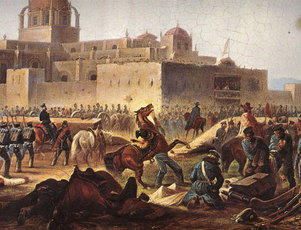Causes of the Mexican Revolution
5.3.2c By: Victor Hibbeln
|
The Mexican War of Independence, which lasted from 1810 to 1821, was set into motion by the Peninsular War. The Peninsular War involved Spain, Portugal, and England, who were all allied against Napoleonic France. The war lasted from 1808 to 1814 as Spain and its allies battled for control of the Iberian Peninsula against Napoleon’s armies. Although Spain was victorious, its social and political structure was weakened because of the war. Thus, it made it difficult for Spain to hold on to Mexico during the revolution. Also during the war, Juntas, or military led government counsels, were installed in Spain’s colony of Mexico. Because of this, the colonists were able to get the chance to govern themselves, thus preparing them for their breakaway from Spain.
Two things that helped spark the revolution were the salons and the location of Mexico. These salons were important because they gave the people a place to talk and discuss ideas. At the salons, during the Peninsular War, people began to discuss enlightenment ideas and independence. These discussions would allow for the revolution to take root with the common people, in turn leading to the support of the revolution by thousands of Mexicans. Because of Mexico’s close proximity to the United States, these enlightenment ideas were able to flow easily between the two countries. Also, the Mexican people were able to see the success of the American Revolution up close, in turn leading them to talks of independence for their own county. Thus, it is clear that the geographic proximity of Mexico to the United States and the salons played a key role in sparking the revolution. Unlike in the United States, the Mexican War of Independence was not able to gain so much momentum so quickly. This is because of the extreme class divide that existed in Mexico. This class divide made it more difficult for the revolution to get underway because many of the upper class citizens and Spanish Royalists still remained loyal to Spain and thus refused to support the revolution. Because of this, the revolution went on for 11 years, with much of it being fought by the peasants and low class citizens. Also, because of this divide the revolution had two different leaders when it first began, Father Hidalgo who led his parishioners from the town of Dolores and Ignacio de Allende, who led some of the few upper class citizens. However, their divided forces were easily defeated by the Spanish. After Hidalgo’s death, the command of the army was taken on by Jose Morelos. Because the country remained divided between upper and lower class, the Mexican forces were able to be easily defeated, thus making the revolution long and drawn out. An effect of this was that the rebel army had many different commanders, thus making it hard for any one of them to lead the revolution for long, with Morelos only serving for four years before his execution in 1815. This frequent change in command made it difficult to bridge the class divide and unite the country. However, once Mexico was unified, they were able to successfully establish their own independence from Spain in 1821. |
|



